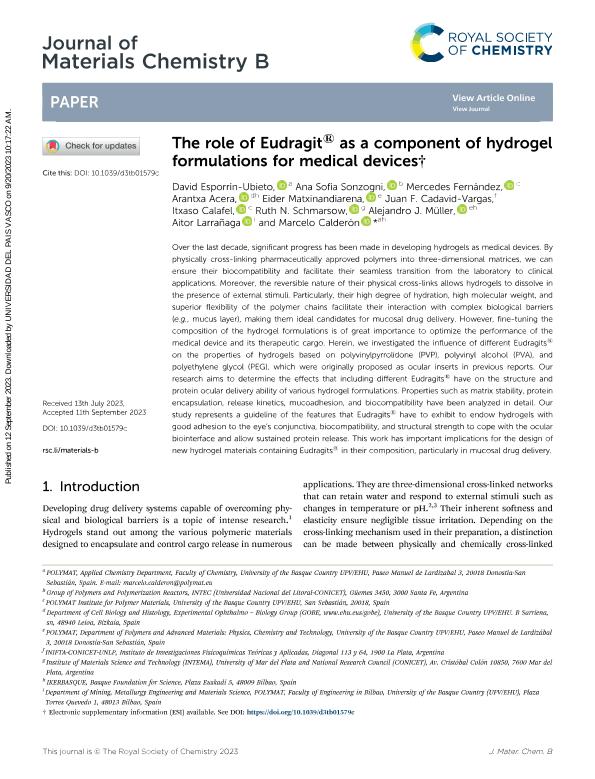Mostrar el registro sencillo del ítem
dc.contributor.author
Esporrín Ubieto, David
dc.contributor.author
Sonzogni, Ana Sofía

dc.contributor.author
Fernández, Mercedes
dc.contributor.author
Acera, Arantxa
dc.contributor.author
Matxinandiarena, Eider
dc.contributor.author
Cadavid Vargas, Juan Fernando

dc.contributor.author
Calafel, Itxaso
dc.contributor.author
Schmarsow, Ruth Noemí

dc.contributor.author
Müller, Alejandro J.
dc.contributor.author
Larrañaga, Aitor
dc.contributor.author
Calderón, Marcelo
dc.date.available
2024-02-05T14:04:28Z
dc.date.issued
2023-11
dc.identifier.citation
Esporrín Ubieto, David; Sonzogni, Ana Sofía; Fernández, Mercedes; Acera, Arantxa; Matxinandiarena, Eider; et al.; The role of Eudragit® as a component of hydrogel formulations for medical devices; Royal Society of Chemistry; Journal of Materials Chemistry B; 11; 38; 11-2023; 9276-9289
dc.identifier.issn
2050-750X
dc.identifier.uri
http://hdl.handle.net/11336/225799
dc.description.abstract
Over the last decade, significant progress has been made in developing hydrogels as medical devices. By physically cross-linking pharmaceutically approved polymers into three-dimensional matrices, we can ensure their biocompatibility and facilitate their seamless transition from the laboratory to clinical applications. Moreover, the reversible nature of their physical cross-links allows hydrogels to dissolve in the presence of external stimuli. Particularly, their high degree of hydration, high molecular weight, and superior flexibility of the polymer chains facilitate their interaction with complex biological barriers (e.g., mucus layer), making them ideal candidates for mucosal drug delivery. However, fine-tuning the composition of the hydrogel formulations is of great importance to optimize the performance of the medical device and its therapeutic cargo. Herein, we investigated the influence of different Eudragits® on the properties of hydrogels based on polyvinylpyrrolidone (PVP), polyvinyl alcohol (PVA), and polyethylene glycol (PEG), which were originally proposed as ocular inserts in previous reports. Our research aims to determine the effects that including different Eudragits® have on the structure and protein ocular delivery ability of various hydrogel formulations. Properties such as matrix stability, protein encapsulation, release kinetics, mucoadhesion, and biocompatibility have been analyzed in detail. Our study represents a guideline of the features that Eudragits® have to exhibit to endow hydrogels with good adhesion to the eye's conjunctiva, biocompatibility, and structural strength to cope with the ocular biointerface and allow sustained protein release. This work has important implications for the design of new hydrogel materials containing Eudragits® in their composition, particularly in mucosal drug delivery.
dc.format
application/pdf
dc.language.iso
eng
dc.publisher
Royal Society of Chemistry

dc.rights
info:eu-repo/semantics/openAccess
dc.rights.uri
https://creativecommons.org/licenses/by-nc/2.5/ar/
dc.subject
Eudragit
dc.subject
Hydrogel
dc.subject
Ocular delivery
dc.subject.classification
Ingeniería de los Materiales

dc.subject.classification
Ingeniería de los Materiales

dc.subject.classification
INGENIERÍAS Y TECNOLOGÍAS

dc.title
The role of Eudragit® as a component of hydrogel formulations for medical devices
dc.type
info:eu-repo/semantics/article
dc.type
info:ar-repo/semantics/artículo
dc.type
info:eu-repo/semantics/publishedVersion
dc.date.updated
2024-02-02T15:32:37Z
dc.identifier.eissn
2050-7518
dc.journal.volume
11
dc.journal.number
38
dc.journal.pagination
9276-9289
dc.journal.pais
Reino Unido

dc.journal.ciudad
Londres
dc.description.fil
Fil: Esporrín Ubieto, David. Universidad del Pais Vasco. Polymat.; España
dc.description.fil
Fil: Sonzogni, Ana Sofía. Consejo Nacional de Investigaciones Científicas y Técnicas. Centro Científico Tecnológico Conicet - Santa Fe. Instituto de Desarrollo Tecnológico para la Industria Química. Universidad Nacional del Litoral. Instituto de Desarrollo Tecnológico para la Industria Química; Argentina
dc.description.fil
Fil: Fernández, Mercedes. Universidad del Pais Vasco. Polymat.; España
dc.description.fil
Fil: Acera, Arantxa. Universidad del Pais Vasco. Polymat.; España. IKERBASQUE; España
dc.description.fil
Fil: Matxinandiarena, Eider. Universidad del Pais Vasco. Polymat.; España
dc.description.fil
Fil: Cadavid Vargas, Juan Fernando. Consejo Nacional de Investigaciones Científicas y Técnicas. Centro Científico Tecnológico Conicet - La Plata. Instituto de Investigaciones Fisicoquímicas Teóricas y Aplicadas. Universidad Nacional de La Plata. Facultad de Ciencias Exactas. Instituto de Investigaciones Fisicoquímicas Teóricas y Aplicadas; Argentina
dc.description.fil
Fil: Calafel, Itxaso. Universidad del Pais Vasco. Polymat.; España
dc.description.fil
Fil: Schmarsow, Ruth Noemí. Consejo Nacional de Investigaciones Científicas y Técnicas. Centro Científico Tecnológico Conicet - Mar del Plata. Instituto de Investigaciones en Ciencia y Tecnología de Materiales. Universidad Nacional de Mar del Plata. Facultad de Ingeniería. Instituto de Investigaciones en Ciencia y Tecnología de Materiales; Argentina
dc.description.fil
Fil: Müller, Alejandro J.. Universidad del Pais Vasco. Polymat.; España. IKERBASQUE; España
dc.description.fil
Fil: Larrañaga, Aitor. Universidad del Pais Vasco. Polymat.; España
dc.description.fil
Fil: Calderón, Marcelo. Universidad del Pais Vasco. Polymat.; España. IKERBASQUE; España
dc.journal.title
Journal of Materials Chemistry B
dc.relation.alternativeid
info:eu-repo/semantics/altIdentifier/url/https://pubs.rsc.org/en/content/articlelanding/2023/tb/d3tb01579c
dc.relation.alternativeid
info:eu-repo/semantics/altIdentifier/doi/http://dx.doi.org/10.1039/D3TB01579C
Archivos asociados
